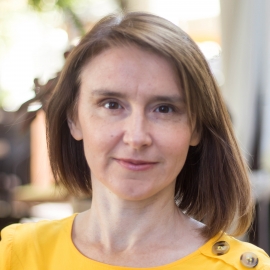The consequences of COVID-19 for society are yet to be studied. However, we can already predict the impact of the pandemic on the situation of women in Ukraine. Their families and their wellbeing, especially that of single mothers, are at risk.
WHO TREATS AND CARES FOR THE SICK?
During the outbreak of diseases caused by the Ebola virus in West Africa in 2014–16, it was found that women were more likely to get infected and sick, given that they took care of their sick family members and worked in the medical sector.
With the rapid increase in the number of people infected with coronavirus and those becoming sick, the burden on the healthcare system and medical workers—most of them women—has increased significantly. Many of them have children who stay at home during the quarantine, and it is unrealistic for these women to keep even standard work hours during this period. In addition, the closure of the Kyiv metro can also affect, first and foremost, the daily mobility of women who work in the medical sector. On the one hand, a considerable number of them cannot switch to working from home (as recommended during the quarantine), while at the same time they cannot afford to use a taxi due to their low salaries.
Data show that more than 90% of healthcare workers in Hubei province are women (according to The Lancet medical journal referring to the State Council Information Office in China).
In Ukraine, 82% of the total number of healthcare workers are women. Most of them work as general practitioners, family doctors, particularly in infectious disease hospitals. According to the latest data from the Poltava Regional Infectious Diseases Hospital, its staff consists of 148 women and 24 men.
I would also like to point out that the number of mid-level medical staff (especially nurses) has decreased in Ukraine. As of 2017, there were 85 mid-level medical female workers for every 10,000 people (in the early 1990s there were 115). This can create additional challenges for the care of sick patients and for the working conditions of the medical staff: as the epidemic worsens, the burden on them increases, and doctors and nurses are often left without proper protection against infection.
The Law of Ukraine “On Amendments to Certain Legislative Acts of Ukraine Aimed at Preventing the Emergence and Spread of Coronavirus Disease (COVID-19)”, adopted on March 17, 2020, establishes additional pay benefits of up to 200% of their salary for medical and other workers who are directly charged with the treatment of people with coronavirus disease for the period of implementation of the measures. This is an appropriate step to support medical workers, most of them women.
Since in Ukraine women are mostly the ones who take care of elderly and sick family members, I suppose it will create yet more challenges in their daily lives.
So, I would assume there is a greater risk for women to become infected with COVID-19 through contact with patients and by taking care of sick family members at home. However, their chances of recovery are somewhat higher, too.
MEN AS THE “WEAKER SEX”: DISEASE AND DEATH RATES.
Generally, men’s death rate from all infectious diseases is higher.
For example, during the 1918 influenza epidemic, young men died more often compared to women of the same age.
In 2017, in Kyiv, 356 men and 150 women died of infectious and parasitic diseases, 75 men and 16 women died of tuberculosis, and 157 men and 80 women died of diseases caused by the human immunodeficiency virus (HIV).
According to research by the Chinese Center for Disease Control and Prevention, which involved 44,000 people, 2.8% of men and 1.7% of women died of the diseases caused by COVID-19. Exact data will be available after the pandemic ends.
The higher death rate among men is partly due to their overall worse health because of lifestyle factors such as smoking. Therefore, men are more severely affected by infectious diseases.
However, there are also biological factors. For example, experts assume that women mount stronger immune responses to vaccination (of course, we are not talking about COVID-19).
WOMEN’S EMPLOYMENT AND BUSINESS.
It is likely that the economic crisis caused by the pandemic will affect all sectors of the economy. Yet today it is possible to assume that the service sector, which employs a large number of women, will be the first to suffer. For example, in 2018, there were 205,600 women among customer service employees, compared to 36,600 men; 419,300 women and 133,800 men worked in the least qualified trade and service professions. Some companies in these fields, especially private ones, presumably send these female workers on unpaid leave.
Ukrainian women who work in the service sector in European countries affected by the virus are also at risk.
Women entrepreneurs also face challenges. According to research data, women account for more than 60% of managers of legal entities in the fields of tourism services, operation of arts facilities, education, hairdressing and other beauty treatments—areas that will be the first to lose profits (see Table 1).

A large number of women are engaged in entrepreneurship in fields that will be shut down for the duration of the quarantine. The share of female individual entrepreneurs in preschool education is 91%, 87% in primary education, 94% in services of hairdressing and other beauty treatment, and 72% in travel agencies. Nearly the only ‘female’ activity among individual entrepreneurs that might be in demand during the quarantine is childcare, where 91% of workers are women (see Table 2).

Women are also the majority among individual entrepreneurs who work in retail trade of clothing, footwear, and food, including sales at markets and uncontrolled outdoor markets. During the quarantine period this trade will be limited or suspended. Women of retirement age often work in this field. Therefore, these restrictions may worsen their condition.
WORK VS CHILDCARE. WHO STAYS AT HOME?
Given that women are the ones who mainly take care of children in Ukrainian families while their income is lower, it is likely they will stay at home to take care of children of preschool and primary school age during the quarantine.
The quarantine can significantly affect the daily life of many women.
If a mother works freelance, the quarantine can make things harder in her daily life by making her balance her work and childcare.

In general, this type of employment is risky for many women due to a lack of labor guarantees, paid sick and maternity leaves, etc., but in quarantine conditions, they are likely to ‘stay afloat’.
However, single mothers experiencing decreased performance can suffer from a significant loss of earnings.
The situation is more complicated in the hired labor sector. If a woman is officially employed, the legislation of Ukraine allows her to use a part of her annual paid leave (or her social leave for a mother of two or more children under 15) or unpaid leave during the quarantine.
Sometimes we hear people say: why do parents complain about the quarantine since school holidays in Ukraine last for three months? Unlike pandemics, summer always comes as expected, so parents can plan childcare during this period in advance. Solutions vary from school camps and other summer camps to a mother’s or father’s planned vacations or the help of relatives.
In contrast, the quarantine situation is unplanned and hence may theoretically be extended depending on the epidemiological situation.
The option of paid or unpaid leave is not available to everyone, especially when it comes to mothers who raise their children on their own, who have neither a ‘financial cushion’ for the duration of the crisis nor relatives who are ready to help with childcare. Consequently, first of all the quarantine may worsen the conditions of single mothers, especially those who work informally with no labour guarantees.
According to surveys of the State Statistics Service, one in five households in Ukraine is a household with children who lack one or both parents. These are mostly children raised by a single mother. And now, let's consider the 488,000 child support enforcement cases in 2018 and draw a disappointing conclusion about challenges the pandemic creates for single mothers in the context of losing their jobs or having their income decreased.
According to a survey of employed mothers I conducted in 2016 in Poltava, 65% of the surveyed mothers expect their parents (grandmother or grandfather) to help them take care of a child in a situation when the mother needs to be at work and her child gets ill or his/her educational institution announces quarantine. Also, 39% of the respondents rely on their husband’s help, 4% rely on their ex-husband’s help (which makes 16% of those mothers who live alone with a child or children). 3% of respondents rely on their neighbors’ help, while less than 1% rely on the help of a hired female worker (babysitter). If there are no available close relatives or neighbors with established informal relationships, some mothers, especially single mothers, face the burning issue of resources they can rely on when being unable to stay home with a child. 13% of women surveyed do not expect any support when they need to take care of a child, including 35% of mothers who live alone with their child or children.
Besides, the current situation with COVID-19 has created an additional challenge for those families that have traditionally relied on the older generation to help care for children, since doctors advise to protect elderly people from social contacts, including children (who may be carriers of the infection), due to the risk of a much more complicated progression of the disease.
Mothers who must work during the quarantine and do not have the resources to care for their child during the epidemic have to take their child with them to their workplace. This happens in a country where a children's area at the workplace is a rarity, while the attitude of society and employers tends to be: “you gave birth, so it’s your problem.”
WHAT SHOULD BE DONE?
The situation of the COVID-19 pandemic and quarantine has intensified the issue of public solidarity and responsibility as never before. Yes, no one is obliged to help one another, but it is possible to do so.
It is important to involve women in decision-making, including decisions regarding the quarantine. The WHO Executive Committee acknowledged the need to involve women in decision-making on COVID-19 outbreak preparedness and response. As Olena Vynohradova rightly points out, “Meanwhile, 15 out of the 16 Cabinet members who made the decision regarding school quarantine yesterday were men. Given their official biographies, I can assume they have neither been on parental leave nor taken a career break related to the upbringing or medical treatment of their children, and therefore do not know what it is like to balance official employment and three weeks of childcare for a child or children of preschool or school age.”
Employers (both in the public and private sectors) should study the needs of female and male workers with family responsibilities in balancing work and childcare. When possible, they should allow female and male workers and workers with small children to work from home or work flexible hours (especially single mothers who take care of and raise children on their own) while keeping their salary.
The Law of Ukraine “On Amendments to Certain Legislative Acts of Ukraine Aimed at Preventing the Emergence and Spread of Coronavirus Disease (COVID-19)” of March 17, 2020, established the possibility of an unpaid vacation for the duration of the quarantine. Unfortunately, this will not protect the most vulnerable categories of female workers.
The government should develop mechanisms to support working parents of preschool children for the duration of the quarantine (at the very least, partially paid sick leave or childcare leave during the quarantine, financial aid to cover babysitting costs, etc.) and introduce tax breaks for individual entrepreneurs working in sectors affected by the lockdown.
Volunteer organisations, babysitters, and anyone who is able could offer childcare assistance for free or at a modest rate.
Translation from Ukrainian by Iryna Malishevska.
















